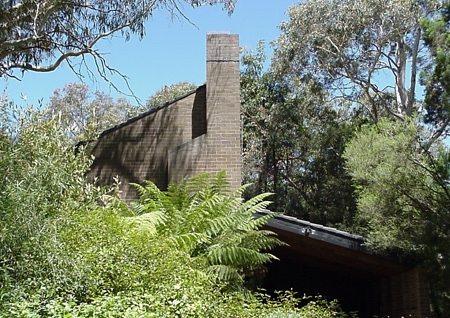38 Mirning Crescent, Aranda (1971-72)

The Wilson house
The Wilson House at 38 Mirning Crescent, Aranda was designed by Canberra architect Roger Pegrum in 1971-72 and completed in 1973. Aranda is located near large tracts of native bushland at the Black Mountain and Aranda Bushland Canberra Nature Parks approximately 8km from Canberra’s city centre and was developed in the late 1960s and early 1970s. The house is an excellent example of the Sydney regional style of architecture.
Significance
The Wilson House at 38 Mirning Crescent is listed on the ACT Chapter of the Australian Institute of Architects Register of Significant Twentieth Century Architecture. The quality, layout and siting of the house on a sloping block within native gardens make a significant contribution to the suburban environment. The house is also regarded as being an advanced design solution for its time, with the clever use of split levels to handle a sloping site and its Japanese character, looking onto the courtyard and garden rather than presenting to the street. This character is further enhanced by the simple and elegant detailing throughout, with the internal and external window frames, originally painted black, framing the landscape.
The house was awarded the C. S. Daley Medal in 1974 and is regarded by the RAIA as an excellent local example of the Sydney Regional style of architecture. In 2005 the Wilson House was awarded the RAIA ACT Chapter 25 Year Award.
Description
The Wilson House is set in a native garden with original eucalypt trees and backs on to a bushland reserve. The site slopes towards the street and the split level house follows the sloping site, with car accommodation on the lowest level. A path winds its way through the native garden to a paved brick walled courtyard, overlooked by the living areas and main bedroom. The plan of the house is roughly a ‘Z’ shape.
The entry leads directly to the dining area and steps down to the living area, which has a high, raked ceiling. The family living area also has a raked ceiling and clerestory lighting; opening directly from this area is the kitchen and steps to the laundry on the level below. An L-shaped corridor leads on from this area to the 5 bedrooms, 2 bathrooms, shower room and an added spa room. Although the Wilson House is carefully planned, it has an informal character and all parts of the house have a pleasant outlook to the native gardens.
The deep boarded timber fascias, timber windows and doors and timber boarding below clerestory windows were originally painted black. Door jambs, skirting and railings are all detailed in ash. The skillion and gable concrete tiled roof forms are massed together to indicate differing functions and the wide eave overhangs are angled underneath to prevent direct sun during summer. Both provide an agreeable scale to the building.
In 1988 the house was extended and altered to a design by Roger Pegrum. This involved a small extension to the kitchen, the addition of a spa room and the conversion of the dressing room to a sitting alcove, with a new dressing room added along the eastern side. These changes had the effect of adding a southern courtyard, and were consistent with the original idea of wrapping the house around an outdoor space.
Source
- Australian Institute of Architects RSTCA citation No. 48
- Royal Australian Institute of Architects 2005 ACT Architecture Awards booklet